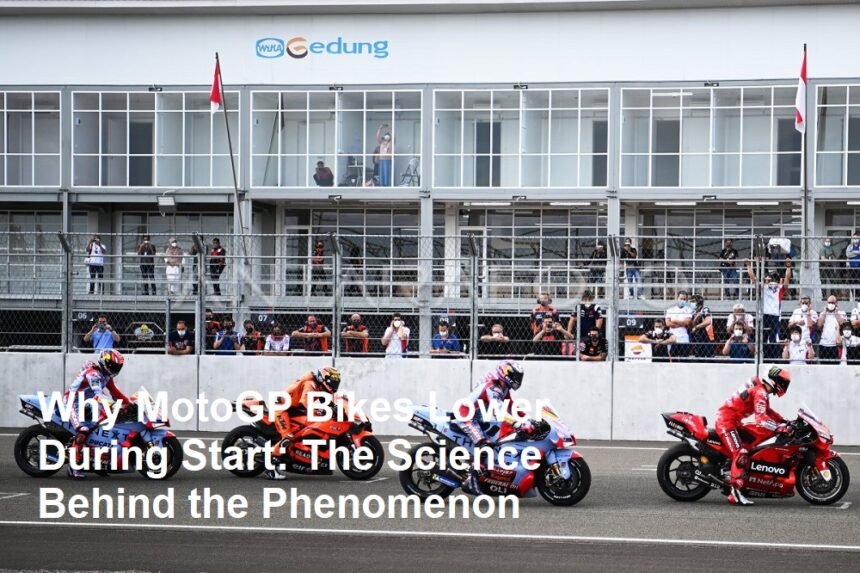MotoGP, the premier class of motorcycle racing, is a sport where precision, speed, and engineering excellence converge. One of the most intriguing moments in a MotoGP race is the start, where riders launch their bikes from a standstill to incredible speeds in mere seconds. During this critical phase, observers often notice that the bikes appear to “lower” or “squat” at the rear. This phenomenon, sometimes referred to as “ceper” in informal terms, is not a coincidence but a result of advanced engineering and physics. Let’s explore why this happens and how it benefits the riders.
- The Role of Suspension in MotoGP Bikes
MotoGP bikes are equipped with highly sophisticated suspension systems, both at the front (forks) and the rear (shock absorber). These systems are designed to handle the extreme forces experienced during racing, such as rapid acceleration, hard braking, and sharp cornering. The suspension ensures that the tires maintain optimal contact with the track, providing stability and control.
During a race start, the rider applies maximum throttle to accelerate as quickly as possible. This sudden burst of power transfers a significant amount of force to the rear wheel, causing the bike to pitch backward. As a result, the rear suspension compresses, making the bike appear lower at the rear. This compression is a natural response to the forces acting on the bike and is essential for maintaining balance and traction.
- Weight Transfer and Traction
When a MotoGP bike accelerates, weight shifts from the front to the rear wheel. This weight transfer is crucial for maximizing traction. The rear tire needs as much grip as possible to convert the engine’s power into forward motion without spinning out. By compressing the rear suspension, the bike ensures that the rear tire maintains optimal contact with the track surface, enhancing traction.
The lowering of the bike during the start is not just a visual effect but a functional one. It helps the rider achieve a faster and more controlled launch off the starting line. Without this suspension compression, the bike would struggle to transfer power efficiently, leading to wheel spin and slower acceleration.
- Launch Control Systems
Modern MotoGP bikes are equipped with advanced electronic aids, including launch control systems. These systems manage the engine’s power delivery during the start to prevent excessive wheel spin and ensure smooth acceleration. The suspension’s behavior during the start is closely tied to these electronic systems.
When launch control is activated, the bike’s suspension is preloaded to handle the expected forces. This preloading ensures that the rear suspension compresses in a controlled manner, further enhancing the lowering effect. The combination of mechanical suspension and electronic aids allows riders to achieve consistent and lightning-fast starts.
- Aerodynamics and Balance
MotoGP bikes are designed with aerodynamics in mind. The lowering of the bike during the start also affects its aerodynamic profile. A lower rear end reduces the bike’s overall height, which can improve stability by lowering the center of gravity. This stability is crucial during the chaotic first few seconds of a race, where riders are jostling for position.
Additionally, the compressed suspension helps maintain balance. As the bike accelerates, the front end tends to lift due to the force of acceleration (a phenomenon known as a “wheelie”). The rear suspension compression counteracts this tendency, keeping the front wheel grounded and ensuring the bike remains stable.
- Rider Technique
While the bike’s engineering plays a significant role, the rider’s technique is equally important. MotoGP riders are trained to optimize their body position during the start. By leaning forward and applying their weight to the front of the bike, they help counteract the rearward pitch and maintain balance. This technique, combined with the bike’s suspension behavior, contributes to the lowering effect.
The lowering of MotoGP bikes during the start is a perfect example of how engineering, physics, and rider skill come together to create a seamless performance. This phenomenon is a result of suspension compression, weight transfer, and advanced electronic systems, all working in harmony to maximize acceleration and control. For MotoGP fans, this subtle yet critical detail is a testament to the complexity and brilliance of motorcycle racing at its highest level.
So, the next time you watch a MotoGP race and notice the bikes squatting at the start, you’ll know it’s not just for show—it’s a carefully engineered response designed to give riders the edge they need to win.













